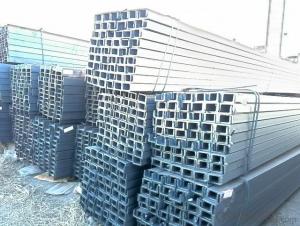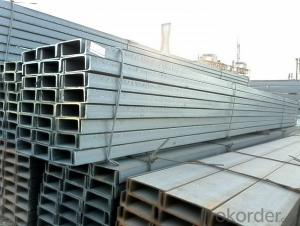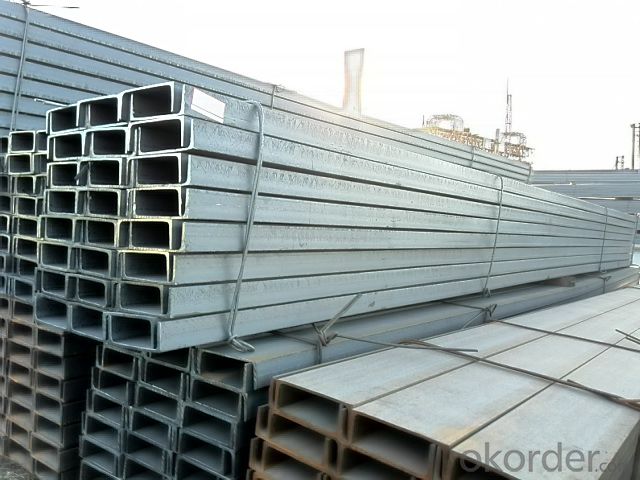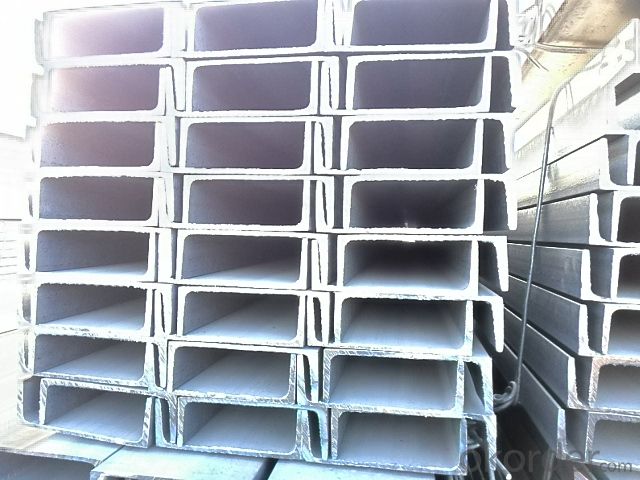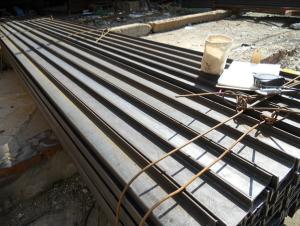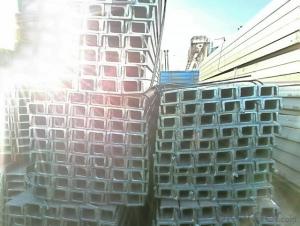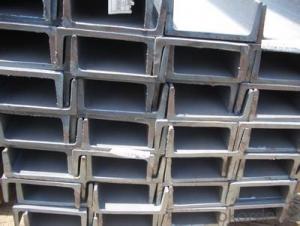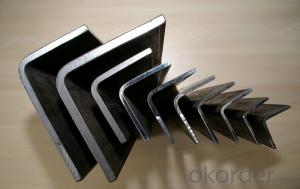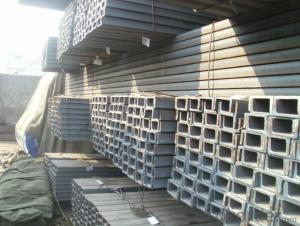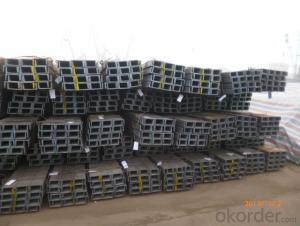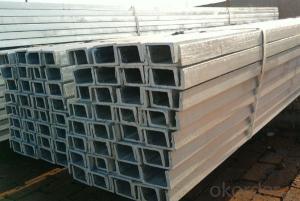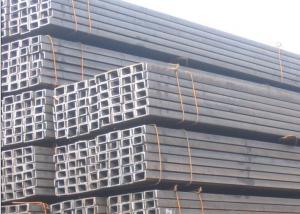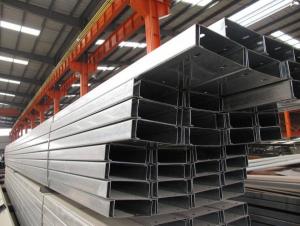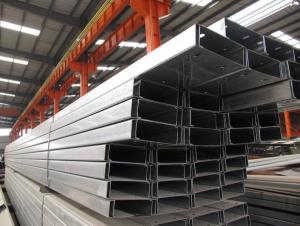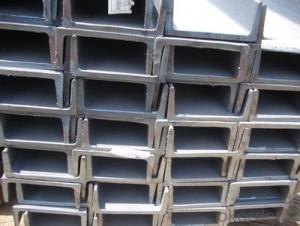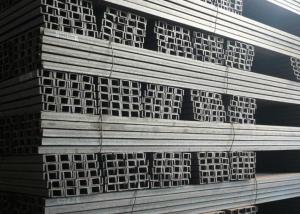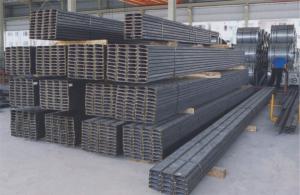JIS U Channels with High Quality and Competitive Price
- Loading Port:
- Tianjin
- Payment Terms:
- TT OR LC
- Min Order Qty:
- 25 m.t
- Supply Capability:
- 10000 m.t/month
OKorder Service Pledge
OKorder Financial Service
You Might Also Like
Product Description:
| Minimum Order Quantity: | 25MT | Unit: | m.t. | Loading Port: | Xingang Port |
| Supply Ability: | 120000TON/Year | Payment Terms: | TT or LC |
Product Applications:
Japanese Standard U-channels are ideal for structural applications and are widely used in the construction of buildings and bridges, and the manufacturing, petrochemical, and transportation industries.
Product Advantages:
OKorder's Japanese Standard U-channels are durable, strong, and resist corrosion.
Main Product Features:
· Premium quality
· Prompt delivery & seaworthy packing (30 days after receiving deposit)
· Corrosion resistance
· Can be recycled and reused
· Mill test certification
· Professional Service
· Competitive pricing
Product Specifications:
Manufacture: Hot rolled
Grade: Q195 – 235
Certificates: ISO, SGS, BV, CIQ
Length: 6m – 12m, as per customer request
Packaging: Export packing, nude packing, bundled
1. We are definitely speciallizing in manufacturing and supplying channel steel as per japanese standard, which is characterised with high mechanical strength and competitive prices.
Original Place | Tangshan, China | Brand Name | UINDA |
Standard | JIS G3192 : 1990 | ||
Material Grade | SS490 | ||
Sizes | 50mm to 200mm | ||
Sales Volume/Year | 3000MT | ||
Destination Area | Middle East, Africa, Southeast Asia | ||
2. The sections in details are as followings in the table-1
JIS U CHANNEL | Standard | Sectional | Dimension |
| Mass: |
| (mm) | (mm) | (mm) | (mm) |
|
50x25 | 50 | 25 | 3.0 | 6.00 | 2.37 |
75X40 | 75 | 40 | 3.8 | 7.00 | 5.30 |
75X40 | 75 | 40 | 4.0 | 7.00 | 5.60 |
75X40 | 75 | 40 | 4.5 | 7.00 | 5.85 |
75X40 | 75 | 40 | 5.0 | 7.00 | 6.92 |
|
|
|
|
|
|
100X50 | 100 | 50 | 3.8 | 6.00 | 7.30 |
100X50 | 100 | 50 | 4.2 | 6.00 | 8.03 |
100X50 | 100 | 50 | 4.5 | 7.50 | 8.97 |
100X50 | 100 | 50 | 5.0 | 7.50 | 9.36 |
|
|
|
|
|
|
125X65 | 125 | 65 | 5.2 | 6.80 | 11.66 |
125X65 | 125 | 65 | 5.3 | 6.80 | 12.17 |
125X65 | 125 | 65 | 5.5 | 8.00 | 12.91 |
125X65 | 125 | 65 | 6.0 | 8.00 | 13.40 |
|
|
|
|
|
|
150x75 | 150 | 75 | 5.5 | 7.30 | 14.66 |
150x75 | 150 | 75 | 5.7 | 10.00 | 16.71 |
150x75 | 150 | 75 | 6.0 | 10.00 | 17.90 |
150x75 | 150 | 75 | 6.5 | 10.00 | 18.60 |
150x75 | 150 | 75 | 6.5 | 10.00 | 24.00 |
|
|
|
|
|
|
200X80 | 200 | 80 | 7.5 | 11.00 | 24.60 |
Table-1
3. The mechanical property of JIS U Channel Steel in the table-2:
Grade | Yield Strength,N/mm² | Extension Strength N/mm² | |||
Thickness of Steel,mm | |||||
≦16 | >16-≦40 | >40-≦100 | >100 | ||
SS490 | ≧285 | ≧275 | ≧255 | ≧245 | 490-610 |
Table-2
4. The chemical composition of JIS U Channel Steel as per SS490 in the table-3
Grade | Element(%) | |||
C | Mn | P | S | |
SS490 | - | - | ≦0.050 | ≦0.050 |
Table-3
FAQ:
Q1: Why buy Materials & Equipment from OKorder.com?
A1: All products offered byOKorder.com are carefully selected from China's most reliable manufacturing enterprises. Through its ISO certifications, OKorder.com adheres to the highest standards and a commitment to supply chain safety and customer satisfaction.
Q2: How do we guarantee the quality of our products?
A2: We have established an advanced quality management system which conducts strict quality tests at every step, from raw materials to the final product. At the same time, we provide extensive follow-up service assurances as required.
Q3: The products are invoicing on theoritical weight or on actual weight?
A3: We can do it in both manners, according to the customers' request.
Images:
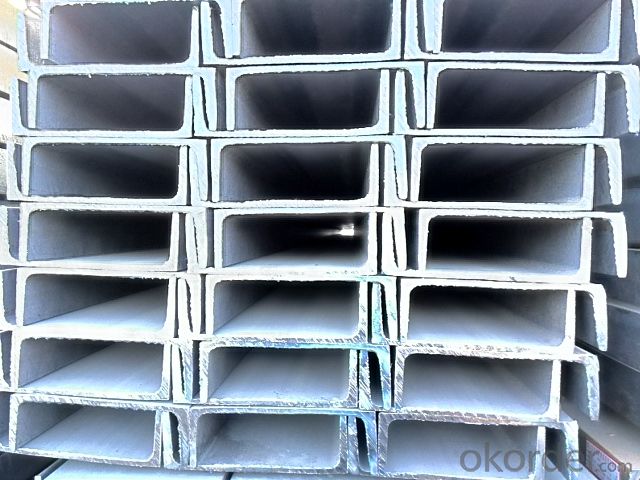
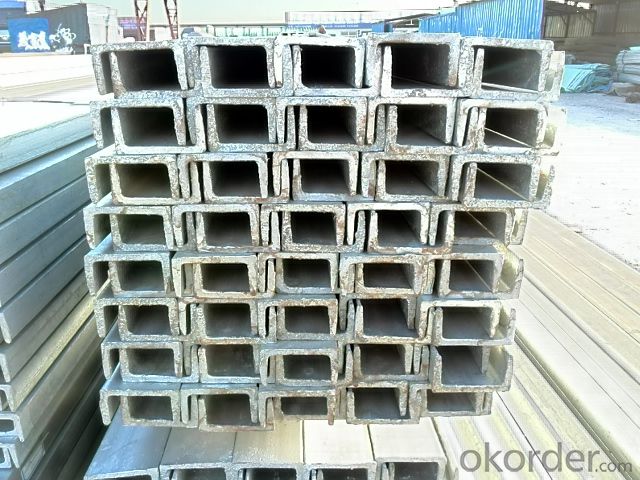
- Q: How do steel channels contribute to the overall safety of a structure during floods?
- Several ways exist in which steel channels contribute to the overall safety of a structure during floods. Primarily, they offer structural support and reinforcement to the building, enhancing its resistance to the forces and pressure exerted by floodwaters. These channels are engineered to endure high loads and distribute weight evenly, thereby ensuring stability and integrity even in extreme flood conditions. In addition, steel channels can be strategically positioned in flood-prone areas to divert the flow of water away from critical parts of the building. By creating barriers or channels, they assist in controlling and managing water flow, averting its entry into vulnerable spaces or damage to the foundation. This redirection of water minimizes the risk of structural failure or collapse during floods. Moreover, steel channels possess high resistance to corrosion, a crucial characteristic in areas prone to flooding where frequent water exposure occurs. Utilizing corrosion-resistant steel channels significantly reduces the risk of deterioration and weakening of the structure due to prolonged water exposure. Furthermore, steel channels can be utilized to fabricate flood-resistant doors and barriers. These doors are designed to withstand the water pressure and prevent its entry into the building. This proves particularly vital in critical areas such as basements or lower levels, where water infiltration can cause extensive damage to utilities or compromise the overall stability of the structure. In summary, steel channels enhance the overall safety of a structure during floods by providing structural support, redirecting water flow, resisting corrosion, and creating flood-resistant barriers. Incorporating these features into the design and construction of a building significantly mitigates the risk of damage and destruction during floods, ensuring the safety of occupants and preserving the structure's integrity.
- Q: Can steel channels be used for pedestrian bridges?
- Yes, steel channels can be used for pedestrian bridges. Steel channels are commonly used in bridge construction due to their strength, durability, and versatility. They offer excellent load-bearing capabilities, allowing pedestrians to safely cross the bridge. Steel channels can be designed and fabricated to meet specific bridge requirements, such as span length, weight capacity, and aesthetic considerations. Additionally, steel channels can withstand harsh environmental conditions, making them suitable for outdoor pedestrian bridges that may be exposed to weather elements. Overall, steel channels are a popular choice for pedestrian bridge construction due to their structural integrity and ability to provide a safe and reliable crossing for pedestrians.
- Q: What are the different types of steel channel connections for wall framing?
- Wall framing can utilize various steel channel connections to ensure stability and strength in the structure. One option is the welded connection, where welding joins the steel channels at their intersection points. This creates a durable and sturdy connection that resists movement and shifting. Another possibility is the bolted connection, which involves using bolts and nuts to secure the steel channels together. This allows for easy assembly and disassembly, making it a preferred choice for temporary structures or those that may require future modifications. A third alternative is the bracket connection, which employs brackets to secure the steel channels. This type of connection is commonly used when a more flexible or adjustable connection is necessitated. Furthermore, specialized steel channel connections exist for specific purposes. For instance, there are connections designed for seismic or high wind load conditions, providing added strength and stability to the wall framing. Ultimately, the selection of a steel channel connection for wall framing depends on factors like desired strength, flexibility, ease of assembly, and project-specific requirements. It is crucial to consult with a structural engineer or an experienced contractor to determine the most suitable type of connection for a particular wall framing application.
- Q: What about the specification of channel steel?
- The specifications are expressed in millimeters of height (H) * leg width (b) * waist thickness (d), such as 80*43*5, which means waist height is 80 mm, leg width is 43 mm, waist thickness is 5 mm channel, or 8# channel steel.
- Q: Can steel channels be used for staircase handrails?
- Yes, steel channels can be used for staircase handrails. Steel channels provide strength and durability, making them a suitable choice for supporting and guiding people along staircases.
- Q: How do steel channels perform in extreme temperatures?
- Steel channels generally perform well in extreme temperatures due to their high melting point and excellent thermal conductivity. However, extreme cold temperatures can cause steel to become brittle, potentially leading to reduced structural integrity. Similarly, extremely high temperatures can cause steel to lose its strength and structural stability. Therefore, while steel channels are generally dependable in extreme temperatures, it is essential to consider the specific conditions and potential impact on their performance.
- Q: Duplex 3, the main beam 3.6 meters, span 4.5 meters wide, steel structure, with 8 channel steel can be, how much space? Or how to make it reasonable? Daily life bears little weight.
- Channel steel deformation, it is recommended to cast in place concrete
- Q: What is the concept of nonstandard channel steel compared with the national standard channel steel? Is there any difference in size between the national standard channel steel and the material?
- Non-standard channel steel, with channel steel waist height, leg width, waist thickness and per meter weight as the standard, non-standard channel steel, mainly in order to not affect the safety quality of the premise of cost saving, in high, wide and thick discount. For example, 12# channel weight per meter 6 meters for 12.059kg, 72.354kg, and 12# 6 if a channel is 48kg, then we call it under 33.3% (1-48/72.354). In our country, most of the steel market has sales of non-standard profiles, this is called "cut foot".
- Q: How do steel channels perform under dynamic loads?
- Steel channels are known for their high strength and load-bearing capacity, making them well-suited for handling dynamic loads. When subjected to dynamic loads, such as vibrations, impacts, or fluctuating forces, steel channels exhibit excellent performance and durability. The structural design of steel channels allows them to effectively distribute dynamic loads throughout their length, preventing localized stress concentrations. This characteristic minimizes the risk of fatigue failure, which is crucial in applications where repeated loading occurs. Steel channels also possess good stiffness, which helps to maintain their shape and integrity under dynamic loads. This stiffness allows them to resist bending, twisting, or deforming, ensuring the overall stability and safety of the structure. Additionally, steel channels are highly ductile, meaning they can withstand significant deformation without fracturing. This ductility is essential in absorbing and dissipating energy during dynamic loading events, such as impacts or earthquakes, reducing the risk of catastrophic failure. Furthermore, steel channels are often used in conjunction with other structural components, such as bolts, welds, or connectors, to enhance their load-bearing capacity. The combination of steel channels with these reinforcements further improves their performance under dynamic loads by increasing their resistance to shear, torsion, and bending forces. In summary, steel channels are well-suited for handling dynamic loads due to their high strength, excellent load distribution capabilities, stiffness, ductility, and compatibility with reinforcements. These qualities make them a reliable choice for various applications that require withstanding dynamic forces, ensuring the durability and safety of the structures they are used in.
- Q: What is the minimum size of channel steel?
- Channel steel is a strip of steel with a cross section. Section steel with groove shape.
Send your message to us
JIS U Channels with High Quality and Competitive Price
- Loading Port:
- Tianjin
- Payment Terms:
- TT OR LC
- Min Order Qty:
- 25 m.t
- Supply Capability:
- 10000 m.t/month
OKorder Service Pledge
OKorder Financial Service
Similar products
Hot products
Hot Searches
Related keywords
